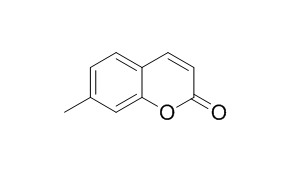7-Methylcoumarin
7-Methylcoumarin is an inhibitor for CYP2A6. It has strong hepatoprotective activity, which could be attributed to its potent antioxidant effects.
Inquire / Order:
manager@chemfaces.com
Technical Inquiries:
service@chemfaces.com
Tel:
+86-27-84237783
Fax:
+86-27-84254680
Address:
1 Building, No. 83, CheCheng Rd., Wuhan Economic and Technological Development Zone, Wuhan, Hubei 430056, PRC
Providing storage is as stated on the product vial and the vial is kept tightly sealed, the product can be stored for up to
24 months(2-8C).
Wherever possible, you should prepare and use solutions on the same day. However, if you need to make up stock solutions in advance, we recommend that you store the solution as aliquots in tightly sealed vials at -20C. Generally, these will be useable for up to two weeks. Before use, and prior to opening the vial we recommend that you allow your product to equilibrate to room temperature for at least 1 hour.
Need more advice on solubility, usage and handling? Please email to: service@chemfaces.com
The packaging of the product may have turned upside down during transportation, resulting in the natural compounds adhering to the neck or cap of the vial. take the vial out of its packaging and gently shake to let the compounds fall to the bottom of the vial. for liquid products, centrifuge at 200-500 RPM to gather the liquid at the bottom of the vial. try to avoid loss or contamination during handling.
Int J Mol Sci.2021, 22(16):8641.
Phytother Res.2022, 10.1002:ptr.7592.
ACS Synth Biol.2022, 11(10):3296-3304.
Molecules.2024, 29(22):5261.
Anal Bioanal Chem.2023, 415(9):1641-1655.
Phytomedicine.2024, 128:155527.
J. Soc. Cosmet. Sci. Korea2016, 163-171
Planta Med.2019, 85(9-10):766-773
Mol Neurobiol.2021, 58(8):3665-3676.
Processes2020, 8(12),1540.
Related and Featured Products
Drug Chem Toxicol. 2013 Jan;36(1):42-7.
Ameliorative effects of 7-methylcoumarin and 7-methoxycoumarin against CCl4-induced hepatotoxicity in rats.[Pubmed:
23126493 ]
The available conventional remedies for the treatment of drug-induced liver diseases are highly inadequate and possess serious adverse effects; therefore, the development of new, effective drugs is considered necessary. This article explores the hepatoprotective and antioxidant potential of 7-Methylcoumarin (MC) and 7-methoxycoumarin (MOC) in CCl(4)-induced hepatotoxicity in rats.
METHODS AND RESULTS:
MC and MOC individually, at doses of 50 and 100 mg/kg body weight, were administered orally once-daily for 7 days. The hepatoprotective activity was assessed using various biochemical parameters, such as alanine aminotransferase (ALT), aspartate aminotransferase (AST), serum bilirubin (TB), total protein (TP), and albumin (TA). Serum antioxidant enzyme [e.g., superoxide dismutase (SOD) and catalase (CAT)] levels were determined. Also, thiobarbituric-acid-related substances (TBARS) levels, along with histopathological studies of liver tissue, were scrutinized. Pretreatment with MC and MOC significantly decreased ALT, AST, and TB in the serum of CCl(4)-induced liver damaged rats in a dose-dependent manner. TA and TP levels in the serum were also restored significantly in all presupplemented MC and MOC groups. In addition, oxidative stress induced by CCl(4) was prevented significantly; thereby, increasing SOD and CAT levels and decreasing TBARS levels in liver homogenates. Histopathological studies revealed the ameliorative natures of both the compounds.
CONCLUSIONS:
This study demonstrates the strong hepatoprotective activity of MC and MOC, which could be attributed to their potent antioxidant effects.
Xenobiotica. 2016;46(1):14-24.
Inhibitory effects and oxidation of 6-methylcoumarin, 7-methylcoumarin and 7-formylcoumarin via human CYP2A6 and its mouse and pig orthologous enzymes.[Pubmed:
26068522 ]
1. Information about the metabolism of compounds is essential in drug discovery and development, risk assessment of chemicals and further development of predictive methods.
METHODS AND RESULTS:
2. In vitro and in silico methods were applied to evaluate the metabolic and inhibitory properties of 6-methylcoumarin, 7-Methylcoumarin and 7-formylcoumarin with human CYP2A6, mouse CYP2A5 and pig CYP2A19. 3. 6-Methylcoumarin was oxidized to fluorescent 7-hydroxy-6-methylcoumarin by CYP2A6 (Km: 0.64-0.91 µM; Vmax: 0.81-0.89 min(-1)) and by CYP2A5 and CYP2A19. The reaction was almost completely inhibited at 10 µM 7-Methylcoumarin in liver microsomes of human and mouse, but in pig only 40% inhibition was obtained with the anti-CYP2A5 antibody or with methoxsalen and pilocarpine. 7-Methylcoumarin was a mechanism-based inhibitor for CYP2A6, but not for the mouse and pig enzymes. 7-Formylcoumarin was a mechanism-based inhibitor for CYP2As of all species. 4. Docking and molecular dynamics simulations of 6-methylcoumarin and 7-Methylcoumarin in the active sites of CYP2A6 and CYP2A5 demonstrated a favorable orientation of the 7-position of 6-methylcoumarin towards the heme moiety. Several orientations of 7-Methylcoumarin were possible in CYP2A6 and CYP2A5.
CONCLUSIONS:
5. These results indicate that the active site of CYP2A6 has unique interaction properties for ligands and differs in this respect from CYP2A5 and CYP2A19.



